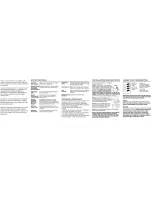
• For mobile home installation, select locations carefully to avoid thermal barriers that may form at the
ceiling. For more details, see MOBILE HOME INSTALLATION below.
• When mounting an alarm on the ceiling, locate it at a minimum of 4” (10 cm) from the side wall (see
Diagram A).
• When mounting the alarm on the wall, use an inside wall with the top edge of the alarm at a mini-
mum of 4” (10 cm) and a maximum of 12” (30.5 cm) below the ceiling (see Diagram A).
• Put smoke alarms at both ends of a bedroom hallway or large room if the hallway or room is more
than 30 feet (9.1 m) long.
• Install Smoke Alarms on sloped, peaked or cathedral ceilings at or within 3ft (0.9m) of the highest
point (measured horizontally). NFPA 72 states: “Smoke alarms in rooms with ceiling slopes greater
than 1 foot in 8 feet (.3m in 2.4 m) horizontally shall be located on the high side of the room.” NFPA
72 states: “A row of detectors shall be spaced and located within 3 ft (0.9m) of the peak of the ceil-
ing measured horizontally” (see diagram “C”).
MOBILE HOME INSTALLATION
Mobile homes built in the past five to seven years have been designed to be energy efficient. Install
smoke alarms as recommended above (refer to RECOMMENDED LOCATIONS and Diagram A).
In mobile homes that are not well insulated compared to present standards, extreme heat or cold can
be transferred from the outside to the inside through poorly insulated walls and roof. This may create a
thermal barrier which can prevent the smoke from reaching an alarm mounted on the ceiling. In such
units, install the smoke alarm on an inside wall with the top edge of the alarm at a minimum of 4” (10
cm) and a maximum of 12” (30.5 cm) below the ceiling (see Diagram A).
If you are not sure about the insulation in your mobile home, or if you notice that the outer walls and
ceiling are either hot or cold, install the alarm on an inside wall. For minimum protection, install at least
one alarm close to the bedrooms. For additional protection, see SINGLE FLOOR PLAN in Diagram B.
DIAGRAM “A”
3 ft
(0.9m)
3 ft
(0.9m)
HORIZONTAL DISTANCE
FROM PEAK
ANYWHERE
IN THIS AREA
DIAGRAM “C”
●
Smoke Alarms for Minimum Protection
●
●
Smoke Alarms for Additional Protection
▲
▲
Ionization Type Smoke Alarms with
“Hush” Control or Photoelectric Type
DIAGRAM “B”
This product is designed to detect products of combustion using the ionization technique. It contains
0.9 microcurie of Americium 241, a radioactive material. Distributed under U.S. NRC License No. 32-
23858-01E. Manufactured in compliance with U.S. NRC safety criteria in 10 CFR 32.27. The pur-
chaser is exempt from any regulatory requirements.
WARNING! REMOVAL OF THE SMOKE ALARM BATTERY AND DISCONNECTING OR LOSS
OF A.C. POWER WILL RENDER THE SMOKE ALARM INOPERATIVE.
ELECTRICAL RATING: 120 VAC, 60HZ, 80mA maximum per alarm (maximum 80mA for originating unit
with 24 devices interconnected).
IMPORTANT! READ ALL INSTRUCTIONS BEFORE INSTALLATION AND KEEP THIS MANUAL
NEAR THE ALARM FOR FUTURE REFERENCE.
CONTENTS OF THIS MANUAL
1 -- RECOMMENDED LOCATIONS FOR SMOKE ALARMS
2 -- LOCATIONS TO AVOID
3 -- INSTALLATION INSTRUCTIONS
4 -- OPERATION AND TESTING
5 -- NUISANCE ALARMS
6 -- MAINTENANCE
7 -- LIMITATIONS OF SMOKE ALARMS
8 -- GOOD SAFETY HABITS
9 -- NRC INFORMATION
10 -- NFPA PROTECTION STANDARD 72
11 -- CALIFORNIA STATE FIRE MARSHAL REQUIRED INFORMATION
12 -- SERVICE AND WARRANTY
This smoke alarm uses an extremely small amount of radioactive element in the ionization chamber
(see Section 9). Do not try to repair the smoke alarm yourself. Refer to the instructions in Section 12
for service.
1. RECOMMENDED LOCATIONS FOR ALARMS
• Locate the first alarm in the immediate area of the bedrooms. Try to protect the exit path as the
bedrooms are usually farthest from the exit. If more than one sleeping area exists, locate additional
alarms in each sleeping area.
• Locate additional alarms to protect any stairway as stairways act like chimneys for smoke and heat.
• Locate at least one alarm on every floor level.
• Locate an alarm in every bedroom.
• Locate an alarm in every room where electrical appliances are operated (i.e. portable heaters or
humidifiers).
• Locate an alarm in every room where someone sleeps with the door closed. The closed door may
prevent the alarm from waking the sleeper.
• Smoke, heat, and combustion products rise to the ceiling and spread horizontally. Mounting the
smoke alarm on the ceiling in the center of the room places it closest to all points in the room.
Ceiling mounting is preferred in ordinary residential construction.

























